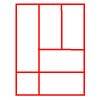Skip over navigation
It might help to write out the lengths of the sides of each triangle in a set.
In the first set, try comparing the shortest side of the first triangle with the shortest side of the third triangle. What do you notice? How about comparing the two "middle length" sides?
Can you use this to work out what the longest side length is in the third triangle?

Or search by topic
Number and algebra
Geometry and measure
Probability and statistics
Working mathematically
Advanced mathematics
For younger learners
Number the Sides
Age 7 to 11
Challenge Level 





- Problem
- Getting Started
- Student Solutions
- Teachers' Resources
It might help to write out the lengths of the sides of each triangle in a set.
In the first set, try comparing the shortest side of the first triangle with the shortest side of the third triangle. What do you notice? How about comparing the two "middle length" sides?
Can you use this to work out what the longest side length is in the third triangle?
You may also like
Is a Square a Rectangle?
How many rectangles can you find in this shape? Which ones are differently sized and which are 'similar'?

